Postman Square, City’s Newest Park
But it does have a long history. The park's roots trace back to 1889.
Postman Square has existed for a long time, but ask the average Milwaukee where or what it is and you’ll be met with a blank stare. The latest placemaking intervention from NEWaukee aims to change that by honoring the space’s history while simultaneously creating a downtown park worth visiting any day of the week. The firm and city formally unveiled the overhauled park today with a ribbon cutting ceremony.
The square, or more correctly, triangle, is a leftover wedge of land between W. Wells St., N. Plankinton Ave. and N. 2nd St. The small pocket park that fills the space is oriented around a central statue honoring the men and women of the 277,000 member National Association of Letter Carriers. A weird place for such a tribute until you learn the history. On August 30th, 1889 just across the street from the park in the former Schaefer’s Saloon at 808 N. Plankinton Ave., a group of 60 mail carriers, many of which were in town for a Civil War veterans convention, got together to form a union. Exactly 100 years later the union dedicated the statue and have returned to clean it every August since.
Mayor Tom Barrett also praised the NEWaukee venture noting “what’s special here is you didn’t need a lot of money.” The park had a $6,000 budget, made up of matching grants from the Greater Milwaukee Association of Realtors and a city Community Improvement Project grant. Barrett noted that the small budget necessitated using more than 100 volunteers to move the redesigned park from the drawing board to reality.
Wisconsin State Association of Letter Carriers president Scott Van Derven was on hand for the ceremony and praised the efforts of NEWaukee to honor the history of the space. He noted the bronze statue, designed by Elliot Offner, depicts the diversity of the letter carriers. A white man in a uniform from 1889, a black man in a uniform from 1939 and a woman in a uniform from 1989.
New Furniture
A substantial amount of new furniture has been added to the park. Painted blue, many of the pieces are subtly shaped like a mailbox. Designed by Ryan Tretow, many of the pieces are movable allowing visitors to adjust them to suit their needs, an important practice advocated by public space expert William Whyte.
The new fixtures in the park also include a mailbox to send letters to Milwaukee. NEWaukee has collected 175 letters to-date, and shares them on their social media channels using the tag #LetterstoMKE.
Tretow and Fojut both are pleased with the adoption of the park to-date, noting that they often go by during the lunch hour and see people using the new dining table.
New restaurant Brunch, which opened across the street at 800 N. Plankinton just a few weeks ago, provided free food to ribbon cutting attendees. NEWaukee hopes to work out dining service in the park with the restaurant.
What’s Next?
Fojut notes that NEWaukee, which refers to the park as Postman’s Plot, “will take feedback from neighbors to invest more in what is used and take away what isn’t.” The physical footprint of the park itself may change.
The city intends to rebuild Wells St. in 2018 and hopes to improve the park as part of that effort. Wells St. was converted to two-way traffic in 2011, which raised the profile of the space by slowing traffic and exposing it from another direction. It also left over a “pork chop” turn lane that the city may convert into part of the park. The turn lane, which connected one one-way street to another, is now closed by a concrete barrier.
Postman Square was referenced in both the 1999 and 2010 Downtown plans as a potential area for redevelopment, and DCD employee Kyle Gast even completed a master’s thesis on the potential for the area. As DCD’s Casanova noted, the area is surrounded by a number of surface parking lots that could be redeveloped. The Germania Building, located immediately south of the park, is being converted from offices into 90 apartments, and should contribute more visitors to the park.
The Triangle Bar
The park wasn’t always so overlooked: it was formerly home to a triangular building, aptly known as the Triangle bar (photo). The tavern was for a while owned by the Cream City Brewing Co., which put it up for sale in 1914. The tavern was demolished in 1919 when the space became a streetcar transfer point. In 1945, Emilie Raasch, widow of Triangle owner Julius Raasch, passed away, and the Milwaukee Journal noted that the tavern was popular during big events Downtown, when patrons would head to the roof to watch a parade go by or see election returns projected from the Germania Building.
Photos
Political Contributions Tracker
Displaying political contributions between people mentioned in this story. Learn more.
- December 31, 2015 - Tom Barrett received $35 from Dan Casanova
- July 31, 2015 - Tom Barrett received $50 from Dan Casanova
Eyes on Milwaukee
-
Church, Cupid Partner On Affordable Housing
 Dec 4th, 2023 by Jeramey Jannene
Dec 4th, 2023 by Jeramey Jannene
-
Downtown Building Sells For Nearly Twice Its Assessed Value
 Nov 12th, 2023 by Jeramey Jannene
Nov 12th, 2023 by Jeramey Jannene
-
Immigration Office Moving To 310W Building
 Oct 25th, 2023 by Jeramey Jannene
Oct 25th, 2023 by Jeramey Jannene


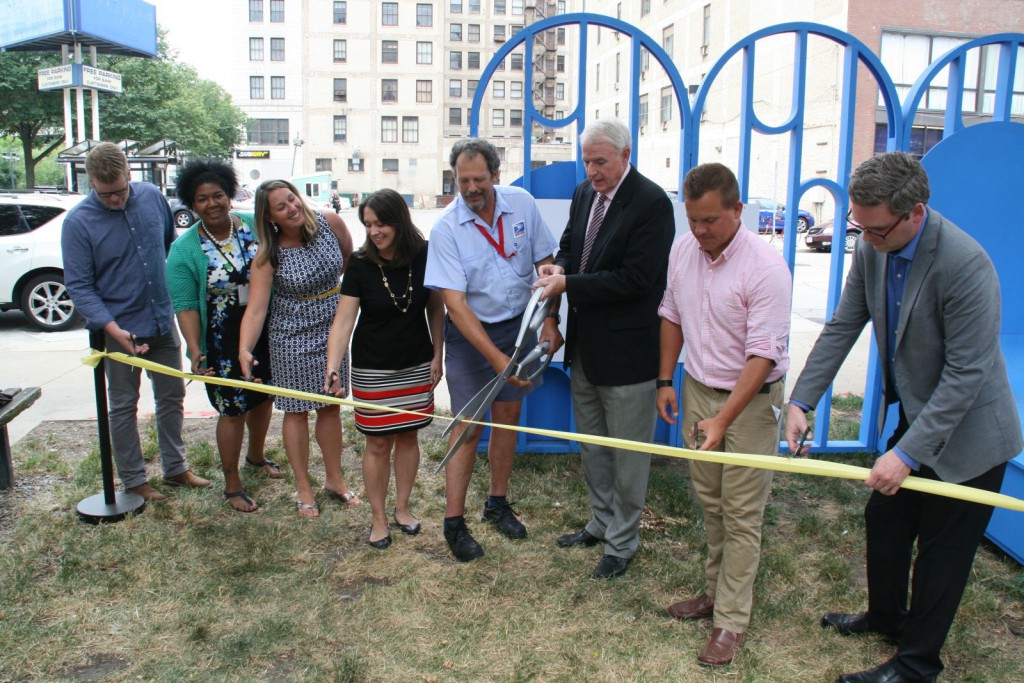
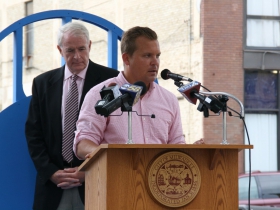
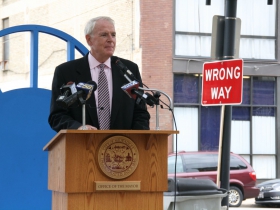
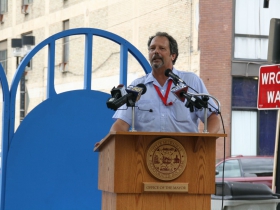
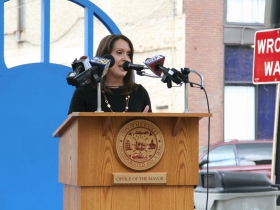
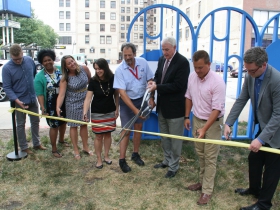
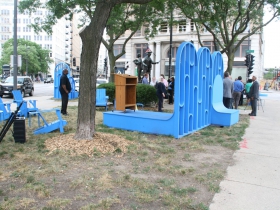




















Not a fan. Though the picture of the citizen looking uncomfortable on the lawn chair is interesting to observe.
Kudos to all involved for breathing new life into this public space and making it more usable.
Since there are so few public mailboxes around town anymore this would be a perfect place to host one of them. That would also bring people to the area.
The Letter Carriers’ Monument and the union history it commemorates deserve more attention and would be benefit from a bigger footprint.
https://en.wikipedia.org/wiki/Letter_Carriers%27_Monument
Just discovered that its sculptor Elliot Offner had an impressive career doing public commissions nationwide (including at Nicollet Mall in MPLS) and as a Smith College professor.
https://en.wikipedia.org/wiki/Elliot_Offner
A Milwaukee Parks’ Tidbit:
There are some little parks that were once on the official docket as named parks. Their origins are found in the proceedings of the Milwaukee Common Council, taxpayer funds were allocated for improvements; they are listed among the entries of existing Milwaukee Parks in Milwaukee City Directories; they were announced in newspapers, etc.
But these little parks were swept under the sod in the switchover from City of Milwaukee jurisdiction to Milwaukee County jurisdiction. Just like that: one clerical moment they’re there, the next clerical moment they’re gone! (If anyone knows otherwise, I’d be happy to known where they’re on the books.)
One of those parks was called Goelz Triangle, created in 1931 to honor the Goelz-Gassen family that settled in the late 1840s in the old Town of Lake, eventually owning on 2 separate parcels in Section 16. They were probably beer drinkers, but not beer barons; they were Gärtners, or “truck farmers”. The last piece of that property left the hands of Goelz descendents in about 2007.
Goelz Triangle was officially located at the intersection of S. Howell Ave., S. Whitnall Ave. and E. Ohio Street – a triangular shape as is the city’s so-called “newest park”. George & Gertrude (Gassen) Goelz’s fine cream city brick home still exists on S. Clement Ave., located directly east of the forgotten park along the line of Ohio Ave. (The Goelz-Gassen home is misidentified on pg. 100 of Ron Winkler’s picture book of Bay View.)
I have to say that I’m not a fan, either. I almost hesitate to say it because I really appreciate the effort and so much of what Newaukee is doing for the City. However…
I walked through the park when I was in town for Father’s Day. I have always loved the statue in the park. However, the big blue furniture (placed on a dirty, ratty carpet, no less) just seemed so overwrought and out of place. (Not all the furniture was in place, yet, but a few of the larger pieces. Since I hadn’t been by the park in quite a while, I actually thought the furniture was old and had been there for years. The furniture pays respect to nothing except the desire to be bold and a child-like (-ish) play on “postal.”
It’s almost as if I decided to apply the principles of place-making but wasn’t really sensitive to the space. (Believe me, I’ve been there when it comes to home decorating. I actually do a pretty good job, but sometimes get it completely wrong.) Postman Square is such a small place and, I believe, calls for an approach more lovely than loud.
I think that Postman Square may also have been the site where, in September 1968, the Milwaukee 14 burned draft files in protest of U.S. involvement in Vietnam.
MidnightSon, I think you’re missing the point, or what I’ve come to understand as the context in which this project and Newaukee operates in.
To me, it seems the greatest opportunity to enhance TEMPORARY public spaces is to remain experimental and create things that take notice and encourage conversation. – which im happy to see you are participating in. If we were talking about a design intended to be PERMANENT, then I think we would be looking at a very different designed response; one closer to the ‘lovely’ you describe. I think it is an above average use of resources given what were likely a number of strict constraints that controlled the project; budget, timing, opinions of all involved, etc.
As far as sensitivity to place, I think the bold / ‘dropped in place’ strategy for the objects does well in providing unexpected contrast to the locale and the landscape. Not only that, but the postal form making is just first layer of “information” that relates to the park. they also built on the theme with an active mailbox managed by Newaukee and made space to deonte additional site history not found on the statue. What else did you want them to add? Also, it sounds as if this installation is up for a year or less before the city makes way for permanent improvements, so Newaukee needed to make an impact and make it fast- this seems an effective way to do so. in that way, it is in fact sensitive to place and to what the growing community around it may want it to become – a more lively place.
Further, Milwaukee does one thing really bad, and that thing is the ability and willingness to take a risk(s). This park effort took advantage of an opportunity and took A RISK, good bad or otherwise. That is very commendable in this town, especially considering they only spent $6k while doing so. We need more risk takers or we’ll forever be lagging behind competing cities. This installation spent mere pennies compared to TheSpot4MKE and numerous PERMANENT extremely high dollar public spaces we now live with.
I agree with the value of taking some affordable risks with our public spaces, which this project does. MKE does need more of that.
The temporary projects done at the Spot4MKE also did that, through a grant through the Project for Public Spaces, the foremost leaders on these types of experiments and consultants on great public-space transformations around the world. PPS’s work speaks for itself and was first inspired by William H. Whyte and Jane Jacobs.
Coincidental or not, 4th Street is now being considered as having more potential than it did for 30 years. People are also now paying more attention to the long-time public site of the lovely “Letter Carriers Monument.” A good thing.
Let’s pay more attention to other public spaces as well. One motto for this type of experimental, low-cost prototyping is to “Fail early and fail often.”
Waste of $6K. Please stop building garbage with 2x4s and putting it in the parks.
Chalk it up to an exercise in place-making. But, the first word in “public space” is “public,” and I’d venture to say that now is not the time for this space.
This isn’t a destination so it would be really helpful to have the “public” already in place. As it is, it’s a small space surrounded by streets that are as wide as it is, that are surrounded by surface parking lots, the empty Germania Building, and the now defunct Renaissance Bookstore.
If you feel you must cajole people into Postman Square, keep it simple: grass, flowers, some tables and chairs (or, shocker: benches), lights strung across the trees for nighttime, and a small ice cream concession in the summer that serves hot chocolate in the winter. I can get all that for $6K. This is what people like, beauty, treats, bright things, and seating (preferably with adequate back support for us “olds.”.)
John Carroll, yes this is the place where 14 men burned draft files in protest of the Vietnam war. There is considerable documentation of this event, including the 14’s statement, and video footage stored now at WTMJ TV’s archives. Robert Graf, one of the 14, has documented the work of several of the 14 after that action. http://www.nonviolentworm.org/Milwaukee14Today/HomePage A photo from the video has been widely published as a keepsake.
The men have continued to be in touch with and returned to Milwaukee for more than one social (not bent on protest) reunion. All of the 14 were convicted of crime; one, Michael Cullen, was convicted in Federal Court and sentenced to return to his native country, Ireland, where he spent the better part of 20 or more years. He now lives in Wisconsin with family
For many protesters it is sacred ground..
Bill Sell, thanks for posting this. I took the video of the Milwaukee 14 event but thought it had been lost after all these years. Part of the Milwaukee 14 action was planned in an apartment I shared with Kaleidoscope photographer Gary Balsieper, who is briefly shown in the video as I panned left. Gary led the news media to the event, though they didn’t know in advance what was going to occur. We hadn’t planned to make a video of the draft file burning, but almost at the last minute Gary gave me his small film camera (a Super 8? I’m not sure) and asked me to film it. I pretty much watched the entire thing through the lens of that little camera. My understanding was that some of the 14 were unhappy about the film, since it might have been used as evidence in their trials. I never knew what became of it. I wonder how it ended up in the WTMJ archives.
Homesteader, thanks for your account. I had thought the person who brought the media to the event was a fellow named John (I will leave his name to add if he wishes). Gary was certainly an interesting person of the time; didn’t he publish the Kaleidoscope (forerunner of today’s Shepherd Express)?
One of the 14 had reservations about the post-action legal strategy; otherwise the men were of a mind to publish and circulate their story. I volunteered to deliver (mail) their statement-press release as soon as I was alerted that the files were burning. They wrote the statement as a group; and were looking forward to a trial to publicize their motives. I’d like to share notes with you; you can message me on facebook (\Bill.Sell)
You can check the archives for the video that made the rounds in 1968. Perhaps it is yours.
Bill, John Kois was editor (and I believe the founder) of Kaleidoscope at that time. Gary Balsieper took many of the photographs for the paper, though I’m sure he also had other roles. Dennis Gall, who recently passed on, was also very involved.
I was quite peripheral to the Milwaukee 14 action, my connection being through my friend Gary. One of the 14 who lived in Milwaukee (I won’t give his name here) had a meeting with Gary in our apartment on Brady Street for which I was present. Gary’s role was take photographs of the building on Wells Street which housed the local draft boards so that those of the 14 from out of town would have a sense of the layout, since they in all likelihood would not have a chance to scope it out in advance for themselves. At the time, I believe it was called the Brumder Building. Gary took photos inside the building and I did the exterior. Gary’s other, more important, role was to meet the media at a downtown location and lead them to the site of the action. I of course knew what was to occur and waited across the street from the little park (in the Yellow Cab I drove in those days to make a living). When the 14 came out of the Brumder Building with the sacks of draft files, I started filming. To avoid possible awkward questions from the police, who seemed quite confused about what was happening, I left shortly after.
Somewhat ironically, my own draft board was located in the Brumder Building and there’s a good chance that my file was among those “napalmed” that day. I very much believe that a plaque of some sort should be installed in the park to commemorate this important episode in the resistance to an unjust war. Count me among those who feel that this is sacred ground.
It’s promising that this space may expand and have more stature beyond its long history as a public space. Many triangles are not named and may not have amenities. However, these public spaces are often adopted by citizens as ad-hoc gardens or park spaces. This one had been elevated by the presence of a significant sculpture but had nonetheless become overlooked, perhaps because neighbors have not embraced it before and it was lacking in comfort and not well maintained.
Thanks to all for sharing its history as the site of the Milwaukee 14 Catholic activists in 1968. That event and their anti-war efforts were in the news for years. Perhaps this history can also be commemorated when the park is permanently redesigned and officially named. I had not previously known that the gender-neutral name for the Letter Carriers Union goes way back to 1889. I would have guessed it was a more recent name.
For anyone interested in knowing more about the Kaleidoscope history, UWM has been assembling its archives and making them available online.
http://collections.lib.uwm.edu/cdm/landingpage/collection/kal
I think it started several years ago with research and a big exhibition relating to the brief but influential run of the Avant Garde Coffeehouse on Prospect Avenue. That has been a terrific multidisciplinary project with numerous creative spinoff events.
http://psoacal.uwm.edu/event/the-shadow-of-the-avant-garde-pioneers/
Of course, a Kaleidoscope co-founder, Bob Reitman, still does an excellent weekly music show Thursday evenings on WUWM, along with his son Bobby. It’s Bod Dylan-inspired name is “It’s All Right, Ma, It’s Only Music.” They do some creative thematic programming with terrific connections between past and present. A Milwaukee cultural treasure. For younger folks and newcomers, Bob Reitman has been a radio mainstay here since those early days.
It is too cluttered and looks like a front lawn rummage sale.
I think that something to commemorate the Milwaukee 14 would be quite appropriate here. I’m fascinated that even an awkward little space such as Postman Square can be so rich in history. We should remember all of it! Thank you to Bill, Homesteader and Virginia for sharing your information.
I, too, am fascinated by all the history. Perhaps this space should be renamed “Triangle Square” and include it, all!
The “John” that Bill Sell references is John Hagedorn. He was charged and convicted by the feds for “conspiracy” with the Milwaukee 14.
In 1968 Hagedorn was one of the leaders of the Milwaukee Organizing Committee–an anti-draft counselling group at UWM. Hagedorn has gone on to a storied career as a Chicago professor and published expert on inner city gang economics–sadly the only means of survival for many in America’s under-class.
Besides helping lead reporters to the Milwaukee 14 event, Ballsieper also took photos. His pix were purchased by Life Magazine (over those submitted by the Milwaukee Journal photographer) and published in a full page spread. One of his photos was also published on a poster lauding the Milwaukee 14.
Hagedorn was charged because he helped plan the event–and delivered to various media offices a cryptic invitation the day before. It instructed reporters to meet in front of the Brumder Building.
As a Milwaukee Sentinel messenger in those days, I personally took Hagedorn’s press release from his hand and gave it to the Sentinel assignment editor. It all became clear to me the next day why Hagedorn (whom I knew) had visited the Sentinel. At the Sentinel’s front desk, we had a friendly chit-chat, and I assured him the invitation would be read by the assignment editor.
I never pass the little triangle park without remembering when it was on America’s front pages.
When I was editor of the Shepherd Express, we ran an anniversary story about the Milwaukee 14 action written by one of the members of the Milwaukee 14. After I left the archives have been removed from internet access, but here”s an interesting web site well done and full of information from that historical day.
Doug, the web site you mentioned seems to have been left off by mistake…
Mike Cullen and his wife Nettie live in Baron County where he is a deacon of the Church.